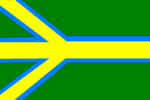Kuhugi language
| Kuhugi | |
|---|---|
 | |
| Regulated by | Kuhugkare Godena (Kuhugi Government) |
| Spoken in | Kuhugstan |
| Total speakers | 1 |
| Family | Isolate |
| Type | Constructed Language |
The Kuhugi language (Kuhugi: Kuhugkesh) is a constructed language based on the phonology of Russian, Polish, Hebrew , Armenian, & Romani, while the grammer is based off of Spanish & Maldivian, even though it is now leaning towards Esperanto.
History
The official language in Kuhugstan, it was developed by Max Kasbar, the current speaker of Kuhugi on July 28, 2011. Even though it tried to be derived from Polish, Russian, Roma, Armenian & Hebrew, there are some constructed elements in the Kuhugi language.
Vocabulary
Vowels
- a [ɑ]
- ä[ɔ]
- á [aɪ]
- e [ɛ]
- é [eɪ]
- i [i]
- o [oʊ]
- u [u]
- ÿ [y]
Consonants
b [b]
d [d]
f [f]
g [g]
h [h]
k [k]
l [l]
m [m]
n [n]
p [p]
r [ɹ]
s [s]
ś [ʃ]
t [t]
v [v]
w [w]
x [χ]
y [j]
z [z]
ź [ʒ]
Useful phrases
- Hello: Sánávas
- Yes: Il
- No: Ela
- Good morning: Ranes kufuzos
- Good evening: Ranes baderos
- Good night: Ranes watyotos
- Goodbye: Alknáven
- What is your name: Xal máyen zoe puna
- My name is John: Yoe puna máyen Kukápa
- How are you: Xap zo gásven
- Do you speak Kuhugi: Fir tanon kesh Kuhugkesh
- I don't understand you: Yo násh komparo tanons
- All right: Rani
- Okay: Gari
- Thank you: Grakos
- You're welcome: Kaniri
- Please: Ranli
- Bless you: Źinos
- Congratulations: Gratimos
- I love you: Yo animen zos
- One beer, please: Taś biros, ya pleto
- What is that: Xal máyen kral
- That is a dog: Kral máyen husua
- Peace: Pisos
Grammar
Kuhugi words are derived by stringing together prefixes, roots, and suffixes. This process is regular, so that people can create new words as they speak and be understood. Compound words are formed with a modifier-first, head-final order, as in English (compare "birdsong" and "songbird," and likewise, śwevháka and hákśweva).
The different parts of speech are marked by their own suffixes: all common nouns end in -a, all adjectives in -e, all derived adverbs in -i, and all verbs in one of six tense and mood suffixes, such as the present tense -o.
Plural nouns used as grammatical subjects end in -ut (if the ending letter is a vowel, use -nut), whereas their direct object forms end in -as. Plural direct objects end with the combination -asut ; -a- indicates that the word is a noun, -ut/-nut indicates the plural, and -s indicates the accusative. Adjectives agree with their nouns; their endings are plural -enut , accusative -es, and plural accusative -enuts.
|
|
The suffix -s, besides indicating the direct object, is used to indicate movement and a few other things as well. The six verb inflections consist of three tenses and three moods. They are present tense -en, future tense -an, past tense -un, infinitive mood -on, conditional mood -in and jussive mood -i (used for wishes and commands). Verbs are not marked for person or number. Thus, haikon means "to sing", yo haiken means "I sing", zo haiken means "you sing", and dosho haiken means "they sing".
|
|
Word order is comparatively free. Adjectives may precede or follow nouns; subjects, verbs and objects may occur in any order. However, the article ye "the", demonstratives such as kral "that" and prepositions (such as nomne "at") must come before their related nouns. Similarly, the negative ela "not" and conjunctions such as hal "and" and yimi "or" must precede the phrase or clause that they introduce. In copular (A = B) clauses, word order is just as important as in English: "people are animals" is distinguished from "animals are people".